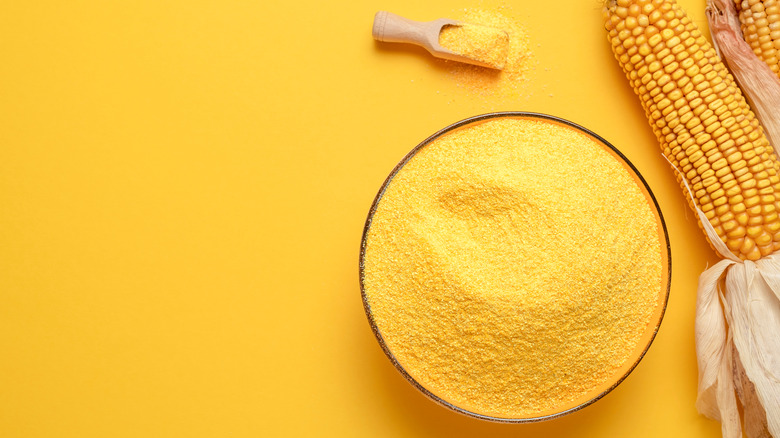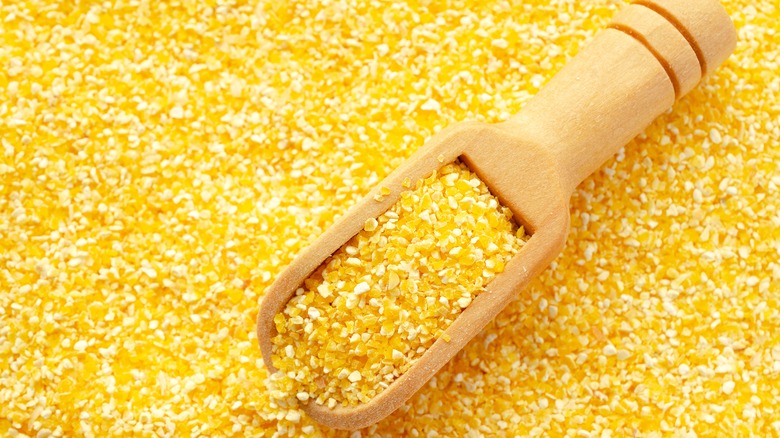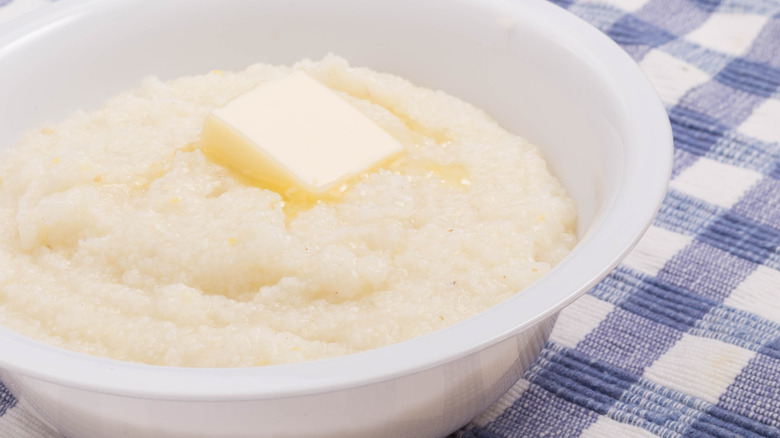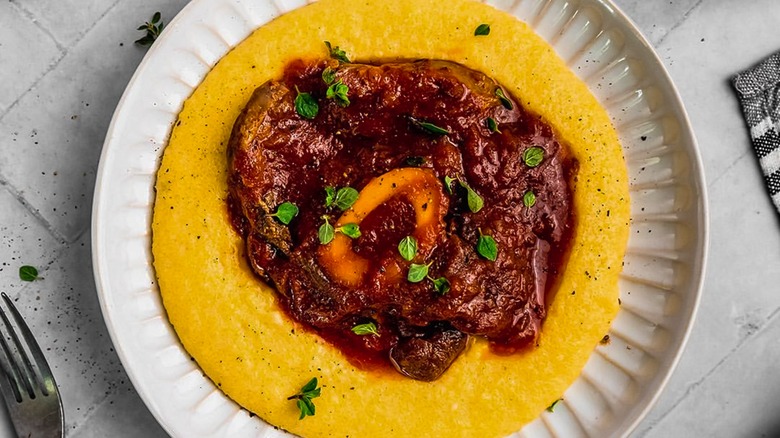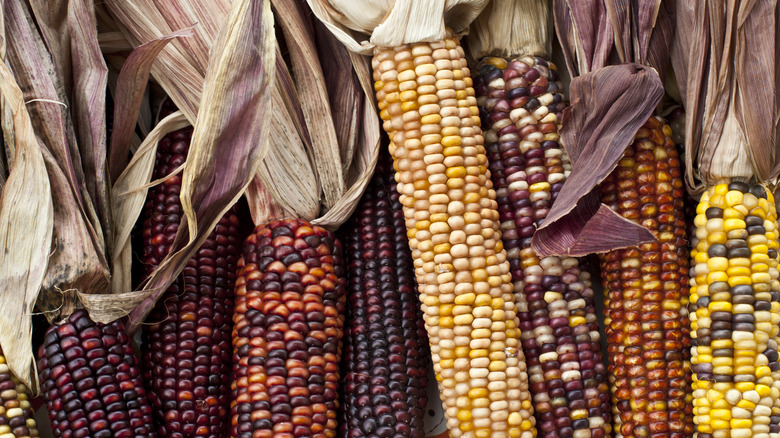Are Cornmeal, Polenta, And Grits Interchangeable?
Dishes made from dried and ground corn provide the base for starchy staples around the globe — though all corn originates in the Americas. In the United States, cornmeal, polenta, and grits are now the most widely available products, but what's the difference, and are they interchangeable in recipes?
Understanding the differences requires getting into the nitty-gritty. Corn can be harvested while young and soft to eat fresh, or it can be left to mature and dry, and be consumed as a grain. Sweet corn is the stuff destined for corn-on-the-cob, cans of kernels, and bags of underrated frozen vegetables. Dent and flint corn are harder and starchier — these sturdy varieties are meant for milling. Cornmeal, polenta, and grits are all made from either dent or flint corn.
Corn is a fruit. But it's also a grain and a vegetable. When intact, each kernel has a tough outer layer called the bran, which encases the germ and endosperm. The bran and germ contain the majority of the protein, fiber, antioxidants, and other nutrients – while the endosperm is primarily starch.
Cornmeal can be made by finely grinding either whole corn kernels or kernels that have had the bran and germ partially or completely removed. Grits are generally ground more coarsely. Polenta typically is made from finely ground flint corn. Depending on the desired consistency of your baked goods or porridge, you can technically substitute any of the three for the other, but each will give you somewhat different results.
The deal with cornmeal
Cornmeal is basically any kind of ground, dried corn, but there are several different types, so it can get a little confusing. Whole grain cornmeal has the most varied texture because the entire corn kernel is being used. It is also the most nutritious and has the most robust flavor. At the store, whole grain cornmeal is often also sold as stone-ground or old-fashioned. Cornmeal can range from coarse to very fine. Corn flour is the most fine grind you can find of cornmeal.
Degerminated or degermed cornmeal has the bran and germ removed, leaving behind only the starchy endosperm. This process decreases the nutritional density of the cornmeal, and for some, makes the taste a bit less interesting. It does however increase the shelf-stability of the product since the germ holds most of the oils. Producers can add nutrients back into the mix after the fact to make enriched cornmeal. Bolted cornmeal is made by grinding the intact kernel and then sifting out some parts, so it also loses some nutrients.
What are grits?
While cornmeal tends to be associated with baked goods and crispy fried foods, grits are almost always associated with porridge — whether that porridge is best served savory or sweet remains up for debate. Grits are also ground, dried corn, but the grind tends to be a bit more coarse — stone-ground and old-fashioned grits vary in texture but are generally the most coarse, and thus take the longest to cook. Finely ground grits labeled as "quick grits" cook in a matter of minutes, and instant grits cook even more quickly because they are already partially cooked.
Grits are almost always made with degerminated cornmeal, which helps to create that characteristic creamy texture, though the copious amounts of butter, cream, and cheese that often feature in grits recipes certainly contribute. Some folks associate grits with white corn, but the use of white or yellow dent corn comes down to preferences, region, and habits — both are widely used.
The association with white-colored grits could also come from hominy grits, which are made from either dried and ground or chopped fresh nixtamalized corn — these methods may not be as common anymore, but hominy grits are definitely still findable in stores. Regardless, white corn grits and hominy grits are not the same thing, though the terms are often confusingly — and mistakenly — used interchangeably.
Is polenta just Italian cornmeal?
Yes, polenta is also just ground, dried corn — though the dish itself predates the introduction of corn to Italy and was previously made with legumes or other grains. Traditionally, polenta is only made with yellow varieties. Also, instead of dent corn, polenta is usually made from flint corn — though there is no legal stipulation that requires it. Flint corn results in a firmer textured porridge, and the grind of the grain is typically more uniform than grits. The taste is a little less corn-forward. Polenta tends to have a milder, more neutral flavor — one that pairs well with many types of ingredients, from seafood to steak.
Polenta can be made with either degerminated or unprocessed corn, which can also be labeled as whole corn. Traditional polenta can take up to around 45 minutes to make, but similar to grits, there are quick-cooking and instant products that are more finely ground and have been partially cooked.
Tips for substituting cornmeal, polenta, and grits
The most important thing to look out for when making a strong substitution is the grind size. Color and type of corn will affect taste and aesthetics some, but the type of grind will change how your cornbread bakes up, the mouthfeel of your porridge, or the way your dredge adheres. For example, coarse, whole-grain cornmeal can stand in well for polenta. Look at the type of grind a recipe calls for. If you want to substitute with something more or less coarse than what the directions are written for, be prepared to make some adjustments to the cooking time. The finer the grind, the more quickly it will cook.
Cornmeal is more finely ground than grits, so if you don't have grits on hand and use cornmeal instead, expect the cooked texture to be smoother. Whole-grain cornmeal will be less creamy when prepared as grits than degerminated cornmeal. Grits and polenta are fairly similar and are easier to swap for one another. Cornmeal and similar products are available with a multitude of different colors, textures, and grinds, so there aren't uniform rules when it comes to cooking time and the amount of liquid necessary. Heed the instructions on the package, and use your best cooking judgment when making substitutions.

